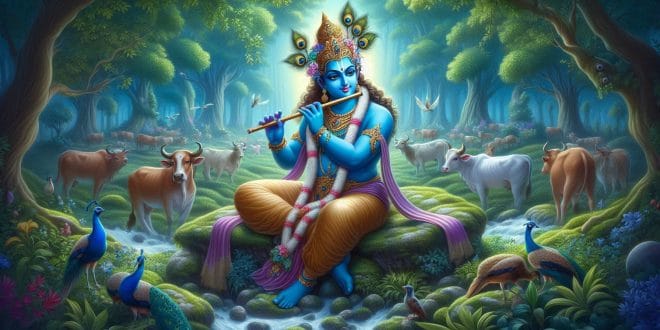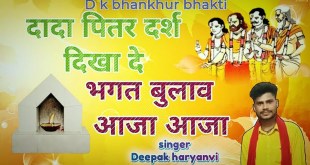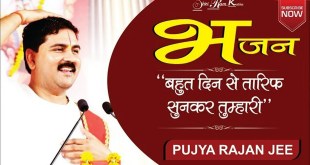Jhula Jhulan padharo Shyama Kunj Bihari Lyrics in Hindi
झूला झूलन पधारो श्यामा कुंज बिहारी।
श्यामा कुंज बिहारी, राधा रसिक बिहारी।
श्यामा बांके बिहारी, राधा रमण बिहारी।
राधावल्लभ लाल, युगल जोरी उजियारी-झूला झूलन पधारो
आई सावन बहार, करे पवनियां शोर।
छाई घटा घनघोर, नाचें मोर चकोर ।।
नाचें भौर पपीहे, कूके कोयल कारी-झूला झूलन पधारो.
घुंघट कलियों ने खोले, आया फूलों पे शबाब ।
चंदन केसर चम्बा, महके मोतिया गुलाब ।।
रसभरी बूंदा-बांदी, चहूं ओर हरियारी-झूला झूलन पधारो.
पड़ा यमुना किनारे, झूला कदम्ब की डार।
ऋतु बड़ी ही सुहानी, पड़े शीतल फुहार ।।
छाया हर्षोल्लास, छाई मस्ती है भारी-झूला झूलन पधारो. झूला पड़ा है तैयार, होवे जय जयकार।
आवो आवो ‘मधुप’, हरि युगल सरकार ।।
आवो झूला झुलावो, हो रही इन्तज़ारी-झूला झूलन पधारो
Jhula Jhulan padharo Shyama Kunj Bihari Lyrics in English
Jhula Jhulan Padharo Shyama Kunj Bihari.
Shyama Kunj Bihari, Radha Rasik Bihari.
Shyama Banke Bihari, Radha Raman Bihari.
Radhavallabh Lal, Yugal Jodi Ujjiyari – Jhula Jhulan Padharo.
Aayi Sawan Bahar, Kare Pwaniyan Shor.
Chhayi Ghata Ghanghor, Nachen Mor Chakor.
Nachen Bhor Papihe, Kooke Koyal Kaari – Jhula Jhulan Padharo.
Ghungat Kaliyon Ne Khole, Aaya Phoolon Pe Shababh.
Chandan Kesari Chamba, Mahke Motiya Gulab.
Rasbhari Boonda-Baandi, Chahoon Or Hariyaari – Jhula Jhulan Padharo.
Pada Yamuna Kinare, Jhula Kadamb Ki Daar.
Ritu Badi Hi Suhaani, Pade Sheetal Phuhaar.
Chhaya Harshollas, Chhayi Masti Hai Bhaari – Jhula Jhulan Padharo. Jhula Pada Hai Taiyaar, Howe Jai Jai Kaar.
Aavo Aavo ‘Madhup’, Hari Yugal Sarkar.
Aavo Jhula Jhulavo, Ho Rahi Intezaari – Jhula Jhulan Padharo.
About Jhula Jhulan padharo Shyama Kunj Bihari Bhajan in English
“Jhula Jhulan Padharo Shyama Kunj Bihari” is a beautiful devotional bhajan that celebrates the divine love of Radha and Krishna. The bhajan is dedicated to the enchanting and playful nature of Lord Krishna and the divine love between Him and Radha, depicted in their famous Yugal Jodi (divine couple). It invites Krishna to come to the Shyama Kunj (a sacred place in Vrindavan associated with Radha and Krishna) to swing (jhula) on a swing, signifying the joyous union of the divine couple.
- The Divine Swing of Radha and Krishna: The central theme of the bhajan is the beautiful scene of Radha and Krishna swinging together in Shyama Kunj. The repeated phrase “Jhula Jhulan Padharo” (Come, swing on the swing) conveys the joy, love, and celebration of divine union, where the divine couple, along with their devotees, revel in the bliss of their company.
- The Beauty of the Monsoon Season: The bhajan beautifully captures the spirit of the monsoon season. “Aayi Sawan Bahar, Kare Pwaniyan Shor” (The monsoon has arrived, bringing a loud sound) refers to the arrival of the rains, which is symbolic of the divine love and joy associated with Krishna and Radha. The monsoon also represents a time of renewal, fertility, and abundance, which is mirrored in the devotion of the followers during this auspicious time.
- Nature’s Celebration of Krishna and Radha: The bhajan describes the natural world coming alive with Krishna and Radha’s divine presence. “Chhayi Ghata Ghanghor, Nachen Mor Chakor” (The dark clouds gather, peacocks and chakors dance) signifies the exuberance of nature celebrating the divine couple. Birds like the peacock and the cuckoo sing and dance, representing the joyful mood of creation in the presence of the Lord.
- The Spiritual and Emotional Connection: The line “Ghungat Kaliyon Ne Khole, Aaya Phoolon Pe Shababh” (The buds have bloomed, and flowers are blooming with fragrance) indicates the spiritual blossoming and emotional opening of the devotee’s heart in Krishna’s presence. The beauty of the season, with its sweet smells and vibrant colors, reflects the joy and divine ecstasy felt by those in the presence of Krishna and Radha.
- Divine Bliss and Ecstasy: The bhajan further speaks of the bliss and ecstasy that comes with divine presence, symbolized through the imagery of the swing. “Pada Yamuna Kinare, Jhula Kadamb Ki Daar” (The swing hangs on the Kadamba tree on the banks of Yamuna) shows the idyllic scene of Krishna and Radha playing together, in harmony with the peaceful surroundings of Vrindavan, with the cool breezes of the season offering comfort and peace.
- Invitation to Krishna: The bhajan concludes with a heartfelt invitation for Krishna to join the divine celebration. “Aavo Aavo ‘Madhup’, Hari Yugal Sarkar” (Come, come, O Madhup, the divine couple, Lord Hari) reflects the devotee’s eager anticipation and longing for Krishna’s presence. The invitation to “swing” symbolizes a yearning for spiritual connection and divine joy.
Overall, “Jhula Jhulan Padharo Shyama Kunj Bihari” is a joyful and devotional bhajan that celebrates the eternal love of Radha and Krishna, capturing the beauty of their divine union in a swing, the spirit of the monsoon, and the celebration of nature and creation in Krishna’s presence. The bhajan invokes a sense of spiritual bliss, emotional surrender, and a deep connection with the divine couple, offering a moment of divine happiness for the devotee.
About Jhula Jhulan padharo Shyama Kunj Bihari Bhajan in Hindi
“झूला झूलन पधारो श्यामा कुंज बिहारी” भजन के बारे में
“झूला झूलन पधारो श्यामा कुंज बिहारी” एक अत्यंत सुंदर और भक्ति से भरा भजन है जो भगवान श्री कृष्ण और राधा रानी के दिव्य प्रेम और मिलन को दर्शाता है। यह भजन राधा और कृष्ण की शरारतों, खेलों और उनके प्रेम में खो जाने की भावना को व्यक्त करता है। इस भजन में कृष्ण और राधा के रिश्ते की मधुरता, भक्ति, और प्रकृति के साथ उनका संबंध प्रस्तुत किया गया है।
- राधा और कृष्ण का दिव्य मिलन: भजन का मुख्य विषय राधा और कृष्ण का प्रेम और उनके बीच का दिव्य मिलन है। “झूला झूलन पधारो श्यामा कुंज बिहारी” (आओ और श्याम कुंज में झूला झूलो) में कृष्ण और राधा के साथ आनंदित होने का आह्वान किया गया है। यह एक खुशी और प्रेम का समय है, जो भक्तों को भगवान के साथ मिलन की गहरी भावना से जोड़ता है।
- सावन और प्रकृति की सुंदरता: भजन में सावन के मौसम के साथ प्रकृति के उल्लास को दर्शाया गया है। “आई सावन बहार, करे पवनियां शोर” (सावन की बहार आई है, हवा में शोर हो रहा है) में बारिश के मौसम की खासियत को रेखांकित किया गया है, जो प्रेम और उल्लास का प्रतीक है। इस मौसम में सब कुछ हरियाली से भरा हुआ होता है, जो कृष्ण और राधा के प्रेम को और भी सुंदर बना देता है।
- प्रकृति की खुशी में राधा और कृष्ण का उत्सव: भजन में कृष्ण और राधा की उपस्थिति के कारण प्रकृति के हर तत्व का आनंद लिया जाता है। “नाचें मोर चकोर, नाचें भौर पपीहे” (मोर और चकोर नाच रहे हैं, भौर और पपीहे गा रहे हैं) में यह दिखाया गया है कि कृष्ण और राधा के प्रेम से हर जीव और पक्षी भी आनंदित होते हैं और उनका प्रेम नृत्य और संगीत में परिणत होता है।
- मनोबल और प्रसन्नता: भजन में बताया गया है कि कृष्ण और राधा के साथ बिताया गया समय न केवल भक्ति बल्कि आनंद, खुशी और प्रसन्नता का समय होता है। “पड़ा यमुना किनारे, झूला कदंब की डार” (यमुना के किनारे कदंब के पेड़ में झूला पड़ा है) में कृष्ण और राधा की प्रेम लीलाओं का संदर्भ मिलता है, जो उनके भक्तों के दिलों को शांति और खुशियों से भर देता है।
- भक्ति में समर्पण और प्रेम का आह्वान: भजन के अंत में भक्त भगवान कृष्ण से निवेदन करता है कि वे आएं और प्रेम से झूला झुलाएं, “आवो आवो ‘मधुप’, हरि युगल सरकार” (आओ आओ ‘मधुप’, हरि युगल सरकार) पंक्ति में भक्त कृष्ण के युगल रूप को साकार करने और उनके साथ दिव्य आनंद में समर्पण करने की इच्छा व्यक्त करता है।
कुल मिलाकर, “झूला झूलन पधारो श्यामा कुंज बिहारी” भजन राधा और कृष्ण के प्रेम, लीलाओं, और उनके मिलन की सुंदरता को दर्शाता है। यह भजन भक्तों को भगवान के साथ आत्मिक जुड़ाव, प्रेम और शांति प्राप्त करने के लिए प्रेरित करता है। इस भजन में प्रकृति के उल्लास, कृष्ण-राधा के संबंधों और दिव्य प्रेम की अभिव्यक्ति है, जो भक्तों के हृदय में गहरी भावना और भक्ति को जागृत करता है।
 Lifeved The Keys to a Better
Lifeved The Keys to a Better




 by
by